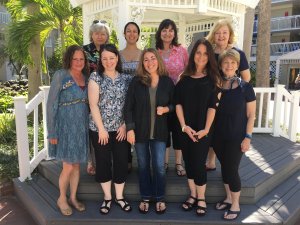At the Novelists Inc conference, I attended several wonderful workshops taught by Joanna Penn. In one of them, she talked about English-language markets outside of the US, and means of making it simple for non-US readers to buy books. Part of that facilitation comes from distribution, and part of it comes from website links. Many of the portals redirect you based upon the location of your ISP (server), but Amazon does not. Amazon has twelve regional stores, each of which has specific links for products like books. I used to have four or five Amazon links (US, UK, AU, CA and DE) but I thought those links cluttered my website pages. Joanna pointed out, rightly so, that it should be easy for non-US readers to click and buy a book at their portal of choice. Since I’m in Canada, it was particularly embarrassing to realize that I wasn’t supporting this on my sites.
And so, there has been a change. 🙂 I’ve been adding some more links to the website, specifically to make it easier for those of you (us!) who live outside the US. In most cases, my books were already available at those portals, but I didn’t have a direct link to them on my websites. That’s all changed.
When you look at any of my book pages now, you’ll see a group of links like this list on the page for Addicted to Love:

What’s new is that the Amazon link is now defined clearly as a link to Amazon.com. It always went to the US store, but now the link says so.
You’ll also see that there’s a new link called Books2Read Universal Link. This is a pretty cool service offered by Draft2Digital, one of the aggregators I use to distribute my books. If you click on this link for Addicted to Love, for example, it’ll take you a page that looks like this:

You can see that there are more buy links here than on my page and that they’re outside the US, but that’s not all. First, if you choose the Amazon Kindle link, you will be taken to the product page for Addicted to Love in your Amazon store based on the location of your server. Yes! It will redirect! If you live outside the US, this could be any of the twelve Amazon stores. You won’t have to fish around to change the link for Canada or Australia anymore: this interface will take you to the right store right away.
Secondly, if you create an account with Books2Read, it will remember what portal you prefer. So, the first time you click a portal on the page above, you’ll see this screen:

If you leave the box checked at the bottom, then every time you click a universal link, you’ll go straight to the product page on your portal of choice. That means that if you click on the Books2Read Universal link for In the Midnight Hour, right here on my website, after you’ve followed the link for Addicted to Love to Amazon.ca, then you will redirected immediately to the Amazon.ca page for that book. You won’t see that first page with all the little icons again. You can, of course, change your preference in your Books2Read account at any time.
How cool is that? I think this is really, really sexy. The other side of this is affiliate codes. Most authors use affiliate codes from the portals, which pay a teeny tiny bonus for sending a customer to their respective store. Amazon, of course, has specific affiliate codes for each individual regional store. (The other portals with affiliate codes use a single code for the entire planet.) This service through Books2Read also supports all of my various Amazon affiliate codes, so each time you use these links, you’re adding a teeny tiny bonus for me. It is literally pennies, but pennies add up.
The final bonus of this is that I get an author page at Books2Read (actually, I get two!) where you can browse my books by series. My Deborah Cooke author page is right here.
The Cooke books are done, and the Delacroix books, though I still have to sort out my dragons and angels at Books2Read. There also are some rogue titles on my book pages that aren’t appearing in their respective series (tsk tsk) but the good peeps at D2D will help me sort this out. It looks good already.
I’ve also signed up for another aggregator to offer my books in more territories and portals beyond the big choices, and will tell you about that soon. 🙂

 Last week, I attended the
Last week, I attended the  And then there was the conference itself. As always, NINC brings together an amazing group of workshop presenters, but this year it was particularly hard to choose between sessions. There were four tracks and it seemed that I wanted to attend two workshops in every time slot. I learned a tremendous amount and made a huge To Do list (this is typical). Highlights for me included
And then there was the conference itself. As always, NINC brings together an amazing group of workshop presenters, but this year it was particularly hard to choose between sessions. There were four tracks and it seemed that I wanted to attend two workshops in every time slot. I learned a tremendous amount and made a huge To Do list (this is typical). Highlights for me included  The truly fabulous thing about this conference, though, was that this was the first time I attended as one of the
The truly fabulous thing about this conference, though, was that this was the first time I attended as one of the 


